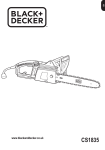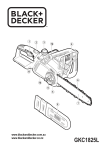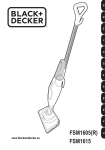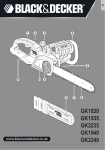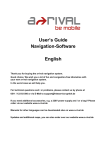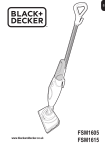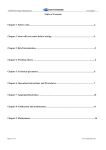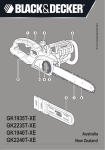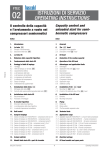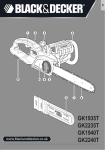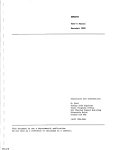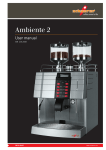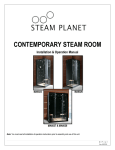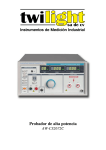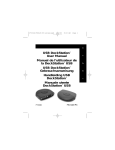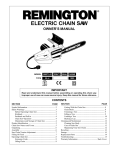Download Australia - New Zealand - Black & Decker Service Technical Home
Transcript
www.blackanddecker.com.au www.blackanddecker.co.nz CS2040 CS2245 2 7 7 8 A 6 6 B 15 16 14 C D 18 E 17 F 3 G H I J K L 4 M N O 5 ENGLISH (Original instructions) Intended use Your BLACK+DECKERTM chainsaw has been designed for pruning and felling trees and cutting logs. This tool is intended for consumer use only. Safety instructions General power tool safety warnings @ Warning! Read all safety warnings and all instructions. Failure to follow the warnings and instructions listed below may result in electric shock, fire and/or serious injury. Save all warnings and instructions for future reference. The term "power tool" in all of the warnings listed below refers to your mains operated (corded) power tool or battery operated (cordless) power tool. 1. Work area safety a. Keep work area clean and well lit. Cluttered or dark areas invite accidents. b. Do not operate power tools in explosive atmospheres, such as in the presence of flammable liquids, gases or dust. Power tools create sparks which may ignite the dust or fumes. c. Keep children and bystanders away while operating a power tool. Distractions can cause you to lose control. 2. Electrical safety a. Power tool plugs must match the outlet. Never modify the plug in any way. Do not use any adapter plugs with earthed (grounded) power tools. Unmodified plugs and matching outlets will reduce risk of electric shock. b. Avoid body contact with earthed or grounded surfaces such as pipes, radiators, ranges and refrigerators. There is an increased risk of electric shock if your body is earthed or grounded. c. Do not expose power tools to rain or wet conditions. Water entering a power tool will increase the risk of electric shock. d. Do not abuse the cord. Never use the cord for carrying, pulling or unplugging the power tool. Keep cord away from heat, oil, sharp edges or moving parts. Damaged or entangled cords increase the risk of electric shock. e. When operating a power tool outdoors, use an extension cord suitable for outdoor use. Use of a cord suitable for outdoor use reduces the risk of electric shock. f. If operating a power tool in a damp location is unavoidable, use a residual current device (RCD) protected supply. Use of an RCD reduces the risk of electric shock. 6 3. Personal safety a. Stay alert, watch what you are doing and use common sense when operating a power tool. Do not use a power tool while you are tired or under the influence of drugs, alcohol or medication. A moment of inattention while operating power tools may result in serious personal injury. b. Use personal protective equipment. Always wear eye protection. Protective equipment such as dust mask, non-skid safety shoes, hard hat, or hearing protection used for appropriate conditions will reduce personal injuries. c. Prevent unintentional starting. Ensure the switch is in the off-position before connecting to power source and/or battery pack, picking up or carrying the tool. Carrying power tools with your finger on the switch or energising power tools that have the switch on invites accidents. d. Remove any adjusting key or wrench before turning the power tool on. A wrench or a key left attached to a rotating part of the power tool may result in personal injury. e. Do not overreach. Keep proper footing and balance at all times. This enables better control of the power tool in unexpected situations. f. Dress properly. Do not wear loose clothing or jewellery. Keep your hair, clothing and gloves away from moving parts. Loose clothes, jewellery or long hair can be caught in moving parts. g. If devices are provided for the connection of dust extraction and collection facilities, ensure these are connected and properly used. Use of dust collection can reduce dust-related hazards. 4. Power tool use and care a. Do not force the power tool. Use the correct power tool for your application. The correct power tool will do the job better and safer at the rate for which it was designed. b. Do not use the power tool if the switch does not turn it on and off. Any power tool that cannot be controlled with the switch is dangerous and must be repaired. c. Disconnect the plug from the power source and/or the battery pack from the power tool before making any adjustments, changing accessories, or storing power tools. Such preventive safety measures reduce the risk of starting the power tool accidentally. d. Store idle power tools out of the reach of children and do not allow persons unfamiliar with the power tool or these instructions to operate the power tool. Power tools are dangerous in the hands of untrained users. (Original instructions) e. Maintain power tools. Check for misalignment or binding of moving parts, breakage of parts and any other condition that may affect the power tools operation. If damaged, have the power tool repaired before use. Many accidents are caused by poorly maintained power tools. f. Keep cutting tools sharp and clean. Properly maintained cutting tools with sharp cutting edges are less likely to bind and are easier to control. g. Use the power tool, accessories and tool bits etc. in accordance with these instructions, taking into account the working conditions and the work to be performed. Use of the power tool for operations different from those intended could result in a hazardous situation. 5. Service a. person using only identical replacement parts. This will ensure that the safety of the power tool is maintained. b. Power to the tool should always be supplied via residual current device with a rated residual current of 30mA or less. Additional power tool safety warnings @ u u u u u u Warning! Additional safety warnings for chainsaws Keep all parts of the body away from the saw chain when the chainsaw is operating. Before you start the chainsaw, make sure the saw chain is not contacting anything. A moment of inattention while operating chain saws may cause entanglement of your clothing or body with the chain saw. Always hold the chainsaw with your right hand on the rear handle and your left hand on the front handle. increases the risk of personal injury and should never be done. Hold the power tool by insulated gripping surfaces only, because the saw chain may contact hidden wiring or its own cord. Saw chains contacting a "live" wire may make exposed metal parts of the power tool "live" and could give the operator an electric shock. Wear safety glasses and hearing protection. Further protective equipment for head, hands, legs and feet is recommended. Adequate protective clothing will reduce the saw chain. Do not operate a chainsaw in a tree. Operation of a chainsaw while up in a tree may result in personal injury. Always keep proper footing and operate the chain saw u u u u u u ENGLISH Slippery or unstable surfaces such as ladders may cause a loss of balance or control of the chainsaw. When cutting a limb that is under tension be alert for spring back. released the spring loaded limb may strike the operator and/or throw the chain saw out of control. Use extreme caution when cutting brush and saplings. The slender material may catch the saw chain and be whipped toward you or pull you off balance. Carry the chain saw by the front handle with the chain saw switched off and away from your body. When guide bar cover. Proper handling of the chain saw will reduce the likelihood of accidental contact with the moving saw chain. Follow instructions for lubricating, chain tensioning and changing accessories. Improperly tensioned or lubricated chain may either break or increase the chance for kickback Keep handles dry, clean, and free from oil and grease. Greasy, oily handles are slippery causing loss of control. Cut wood only. Do not use chainsaw for purposes not intended. For example: do not use the chainsaw for cutting plastic, masonry or non-wood building materials. Use of the chainsaw for operations different than intended could result in a hazardous situation. Causes and operator prevention of kickback Kickback may occur when the nose or tip of the guide bar touches an object, or when the wood closes in and pinches the saw chain in the cut. Tip contact in some cases may cause a sudden reverse reaction, kicking the guide bar up and back towards the operator. Pinching the saw chain along the top of the guide bar may push the guide bar rapidly back towards the operator. Either of these reactions may cause you to lose control of the chainsaw which could result in serious personal injury. Do not rely exclusively upon the safety devices built into your chainsaw. As a chainsaw user, you should take several steps to keep your cutting jobs free from accident or injury. Kickback is the result of tool misuse and / or incorrect operating procedures or conditions and can be avoided by taking proper precautions as given below: u cling the chainsaw handles. With both hands on the chainsaw, position your body and arm to allow you to resist kickback forces. Kickback forces can be controlled by the operator, if proper precautions are taken. Do not let go of the chainsaw. u Do not overreach and do not cut above shoulder height. This helps prevent unintended tip contact and enables better control of the chainsaw in unexpected situations. 7 ENGLISH (Original instructions) Only use replacement guide bars and chains specified by the manufacturer. Incorrect replacement guide bars and chains may cause chain breakage and/or kickback. u Follow the manufacturer's sharpening and maintenance instructions for the saw chain. Decreasing the depth gauge height can lead to increased kickback. u Striking metal, cement or any other hard material near the wood, or buried in the wood can cause kickback. u A dull or loose chain can cause kickback. u Do not try to insert into a previous cut. As this could cause kickback. Make a fresh cut every time. u Safety recommendations for the chainsaw We strongly recommend that first time users obtain practical instruction in the use of the chainsaw and protective equipment from an experienced user. Initial practice should be completed sawing logs on a saw horse or cradle. u Maintain your chainsaw when not in use. Do not store your chainsaw for any length of time without first removing the saw chain and guide bar which should be kept immersed in oil. Store all parts of your chainsaw in a dry, secure place out of reach of children. u We recommend you drain the oil reservoir prior to storage. u Be sure of your footing and pre-plan a safe exit from a falling tree or branches. u Use wedges to help control felling and prevent binding the guide bar and saw chain in the cut. u Saw chain care. Keep the saw chain sharp and snug on the guide bar. Ensure the saw chain and guide bar are clean and well oiled. Keep handles dry, clean and free from oil and grease. u Avoid cutting Prepared timber. Into the ground. u Into wire fences, nails. etc. u Safety of others This appliance is not intended for use by persons (including children) with reduced physical, sensory or mental capabilities, or lack of experience and knowledge, unless they have been given supervision or instruction concerning use of the appliance by a person responsible for their safety. u Children should be supervised to ensure that they do not play with the appliance. u Residual risks. Additional residual risks may arise when using the tool which may not be included in the enclosed safety warnings. These risks can arise from misuse, prolonged use etc. Even with the application of the relevant safety regulations and the implementation of safety devices, certain residual risks can not be avoided. These include: u Injuries caused by touching any rotating/moving parts. u Injuries caused when changing any parts, blades or accessories. u Injuries caused by prolonged use of a tool. When using any tool for prolonged periods ensure you take regular breaks. u Impairment of hearing. u Health hazards caused by breathing dust developed when using your tool (example:- working with wood, especially oak, beech and MDF.) Vibration The declared vibration emission values stated in the technical data and the declaration of conformity have been measured in accordance with a standard test method provided by EN 60745 and may be used for comparing one tool with another. The declared vibration emission value may also be used in a preliminary assessment of exposure. u Additional safety instructions Ensure someone is nearby (but at a safe distance) in case of an accident. u If for any reason you have to touch the saw chain, make sure your chainsaw is disconnected from the mains. u The noise from this product can exceed 85 dB(A). We therefore recommend you take appropriate measures for the protection of hearing. u When handling the product the chain bar may become hot, handle with care. u 8 Warning! The vibration emission value during actual use of the power tool can differ from the declared value depending on the ways in which the tool is used. The vibration level may increase above the level stated. When assessing vibration exposure to determine safety measures required by 2002/44/EC to protect persons regularly using power tools in employment, an estimation of vibration exposure should consider, the actual conditions of use and the way the tool is used, including taking account of all parts of the operating cycle such as the times when the tool is switched off and when it is running idle in addition to the trigger time. (Original instructions) Labels on tool The following pictograms are shown on the tool: : Warning! To reduce the risk of injury, the user must read the instruction manual. Wear eye, ear and head protectionwhen using this product. Electrical safety # u Wear non-silp safety footwear when using the product. R Wear non-silp, heavy dutygloves when using this product. Do not expose the tool to rain or high humidity. Directive 2000/14/EC guaranteed sound power. E Remove plug from the mains immediately before maintenance or if cable is damaged or cut. Caution: Do not over tighten. Tighten by hand. Finger tight only. Chain oil. Moving direction of the chain (Marked under teh sprocket cover).. Rotate to adjust chain tension, clockwise tighten the chain, Anti-clockwise to loose the chain. Hold and operate the saw properly with both hands. ENGLISH This tool is double insulated; therefore no earth wire is required. Always check that the power supply corresponds to the voltage on the rating plate. If the supply cord is damaged, it must be replaced by the manufacturer or an authorised BLACK+DECKER Service Centre in order to avoid a hazard. Using an extension cable u Always use an approved extension cable suitable for the power input of this tool (see technical data). The extension cable must be suitable for outdoor use and marked accordingly. Up to 30 m of HO7RN-F 2 X 1.5 mm² extension cable can be used without loss of product performance. Before use, inspect the extension cable for signs of damage, wear and ageing. Replace the extension cable if damaged or defective. When using a cable reel, always unwind the cable completely. Voltage drops u Under certain power supply conditions this product maycause short-time voltage drops during start-up. u Other equipment may be affected. For example, electriclights may temporarily reduce in brightness. u Contact the supply authority, if necessary, to determine that the impedance of the power supply is lower than 0.172/0.293 ohms. Disturbances are unlikely to occur under this condition. Guard against electric shock u Prevent body contact with earthed or grounded surfaces (e.g. metal railings, lamp-posts etc.). Electric safety can be further improved by using a high-sensitivity (30 mA/ 30mS) Residual Current Device (RCD). : Do not operate the saw using only one hand. Warning! The use of an RCD or other circuit breaker unit does not release the operator of your chainsaw from the safety instructions and safe working practices given in this user manual. Features Contact of teh guide bar tip with any object should be avoided! Tip contact may case the guide bar to move suddenly upward and backward, which may cause serious injury. Warning! Do not touch chain at the chip ejection point. 1. 2. 3. 4. 5. 6. On/off switch Lock-off button Front guard/chain brake assembly Guide bar Chain Chain cover assembly 9 ENGLISH 7. 8. 9. 10. 11. 12. 13. (Original instructions) Chain adjust locking knob Chain tension adjustment wheel Chain sheath Power cord Power cord retainer Oil cap Oil level indicator Before use and after every 10 minutes of use, you must check the chain tension. u Disconnect the tool from the mains supply u tension is correct when the chain (5) snaps back after being pulled 3 mm away from the guide bar (4). There should be no "sag" between the guide bar (4) and the chain (5) Assembly @ @ @ Warning! Always wear protective gloves when working on your chainsaw. Warning! Before performing any assembly or maintenance on power tools, switch off and disconnect from mains. Warning! Remove the cable tie that attaches the chain to the chainbar before assembly. u Place the chainsaw onto a stable surface. Set the front guard/chain brake assembly (3) to the u Rotate the chain adjust locking knob (7) counterclockwise u u u u Place the chain (5) over the guide bar (4) making sure that the saw chain cutters on the upper part of the guide bar Guide the chain (5) around the guide bar (4) and pull it to create a loop to one side at the rear end of the guide bar (4). Guide the chain (5) around the drive sprocket (14), line up the slot in the guide bar and the centre hole of the chain Note: rotate chain tensioning wheel as necessary to line centre hole with bolt (15). Warning! Make sure that the front guard/chain brake assemu u Place the chain cover assembly (6) onto the chainsaw. Make sure that the tab (17) on the chain cover assembly E). Rotate the chain adjust locking knob (7) clockwise until snug. u Check the tension - see 'Checking the chain tension' below. uIf chain tension is loose - see 'Increasing the chain tension' below. u 10 Loosen the chain adjust locking knob (7) counterclockwise one half turn. u Turn the chain tension adjustment wheel (8) clockwise until slight resistance is felt. u Check tension - see 'Checking the chain tension'. u If satisfactory, re-tighten locking knob (7), or if more tension is required, turn adjustment wheel (8). Then re-tighten locking Knob (7). Note: Do not over-tension the chain as this will lead to excessive wear and will reduce the life of the guide bar and the chain. Note: When the chain is new, check the tension frequently u use because a new chain stretches slightly. Use Warning! Let the tool work at its own pace. Do not overload. u recommended chain oil. You can see the oil level in the oil u Periodically switch off and check the oil level indicator (13); if it is less than a quarter full, disconnect your chain- Oiling the chain This chainsaw is equipped with an automatic oiling system that keeps the saw chain and guide bar constantly lubricated. We recommend that you use only BLACK+DECKER oil during the lifetime of your chainsaw because mixtures of different oils could lead to the oil becoming degraded, which can drastically shorten the lifetime of the saw chain and create additional risks. Never use waste oil, thick oil or very thin sewing machine oil. These may damage your chainsaw .Only use the correct grade of oil (cat. no. A6023-50). u The chain saw will automatically feed oil to the chain dur ing use. (Original instructions) u It is normal for a small amount of excess oil to from the chain saw bar and chain during storage. Do not store chain saw on top of anything that may be damaged by the dripping oil. u Make sure that the tool is disconnected from the mains supply. Pull the front guard/chain brake assembly (3) back into the u The tool is now ready to use. u u u u off button (2) and then push the on/off switch (1) to start. When the motor starts, remove your thumb from the lock button (2) and grip the handle firmly. Do not force the tool, allow the tool to do the work. It will do a better and safer job at the speed for which it is designed. Excessive force will stretch the saw chain (5). u How the anti-kickback chain brake works In the event of kickback, your left hand comes in contact with the front guard, pushing it forwards, toward the workpiece, and stops the tool within a few fractions of a second. How to test the anti-kickback chain brake (fig. A) u Always check that the kickback brake operates correctly before use. u Grip the tool firmly in both hands on a firm surface make sure the saw chain (5) is clear of the ground and switch on (see" How to switch the chainsaw on"). u Rotate your left hand forward around the front handle so that the back of your hand comes in contact with the front guard/chain brake assembly (3) and push it forwards, toward the workpiece (fig. A). The saw chain (5) should stop within a few fractions of a second. To reset after the operation of the front guard/chain brake assembly (3) follow the instructions for "How to set the chain brake". Note: Avoid re-starting the tool until you hear the motor come to a complete rest. Note: If chain brake in malfunctioning take the product to an approved BLACK+DECKER service centre. If the saw chain (5) or guide bar (4) becomes jammed u Switch the tool off. u Disconnect the tool from the mains supply. Open the cut with wedges to relieve the strain on the guide bar (4). Do not try to wrench the chainsaw free. Start a fresh cut. Felling (fig. I - K) Inexperienced users should not attempt to fell trees. The user may suffer injury or cause damage to property as a result of failure to control the direction of fall, the tree may splinter or damaged/dead branches may fall during cutting. The safe distance between a tree to be felled and bystanders, buildings and other objects is at least 2 1/2 times the height of the tree. Any bystander, building or object within this distance is at risk from being struck by the tree when felled. Switching on Note: It will not be possible to switch the tool on if the front guard/chain brake assembly is not in the "set" position. ENGLISH Before attempting to fell a tree: u Make sure that there are no local by-laws or regulations that would prohibit or control the felling of the tree. u Consider all conditions that may affect the direction of fall, including: u The intended direction of fall. u The natural lean of the tree. u Any unusual heavy limb structure or decay. u Surrounding trees and obstacles including overhead lines and underground drains. u The wind speed and direction. Pre-plan a safe exit from falling trees or branches. Make sure that the exit route is clear of obstacles that would prevent or hinder movement. Remember that wet grass and freshly cut bark is slippery. u Do not attempt to fell trees where the tree diameter is greater than the cutting length of the chainsaw. u Cut a direction notch to determine the direction of fall. u Make a horizontal cut to a depth of between 1/5th and 1/3rd of the diameter of the tree, perpendicular to the line u u and make a notch of about 45°. Make a single horizontal felling cut from the other side 25 u J). Do not cut through to the direction notch, you could lose control of the direction of fall. Drive a wedge or wedges into the felling cut to open it and Pruning trees Make sure that there are no local by-laws or regulations that would prohibit or control the pruning of the tree limbs. Pruning should only be undertaken by experienced users there is an increased risk of the saw chain pinching and kick back. 11 ENGLISH (Original instructions) Before pruning consideration should be given to conditions affecting the direction of fall including: u The length and weight of the branch to be cut. u Any unusual heavy limb structure or decay. u Surrounding trees and obstacles including overhead. u The wind speed and direction. u The branch being intertwined with other branches. The operator should consider access to the tree limb and the direction of fall. The tree branch is liable to swing towards the tree trunk. In addition to the user bystanders, objects and property below the branch will be at risk. u tion to a maximum depth of one third the diameter of the branch. Removing the branches from a fallen tree. When limbing, leave larger lower limbs to support the log off the ground. Remove the small limbs in one cut. Branches under tension should be cut from the bottom of the branch towards the top to avoid binding the chain saw. Trim limbs from opposite side keeping tree stem between you and saw. Never make cuts with saw between your legs or straddle the limb to be cut. - Troubleshooting Problem Possible cause Possible solution Tool will not start Lock button not Press the lock button. pressed. u Front guard in the How you should cut depends on how the log is supported. Use a saw horse whenever possible. Always start a cut with the saw chain running and the spiked bumper (20) in contact tion of the spiked bumper against the wood. Blown fuse Replace fuse Tripped RCD Check RCD TMains loead not Check mains supply connected When supported along its whole length: u Make a downward cut, but avoid cutting the earth as this will blunt your saw chain quickly. Chain does not stop Chain tension is too within 2 seconds slack When supported at both ends: u First, cut one third down to avoid splintering and second, Bar/chain appear hot/ Oil tank empty smoking Oil hole blocked on switched off Check oil tank level E) and clear the groove around the edge of the When supported at one end: u First cut one third up to avoid splintering and second, cut down to prevent splintering. chainbar. Chain tension is too Check chain tension tight When on a slope: u Always stand on the uphill side. Chainsaw does not Guide bar sprocket Oil the guide bar nose needs greasing sprocket nose Chain on backwards Check/modify chain direction cut well Secure the workpiece using chocks or wedges. The user or a bystander should not steady the log by sitting or standing on it. Make sure that the saw chain does not contact the ground. Check chain tension when the tool is chain bar u Reset front guard brake position Sharpen Chainsaw not using Debris in tank Empty oil from tank and replace oil Oil hole in cap blocked Remove debris from hole This is strongly recommended whenever possible. u Position the log in a stable position. Always cut on the outside of the saw horse arms. Use clamps or straps to secure the workpiece. 12 Debris in chain bar Remove debris and clean the chain bar Debris in oil outlet Remove debris (Original instructions) ENGLISH Maintenance Mains plug replacement (U.K. & Ireland only) Warning! Before performing any maintenance on power tools: u Switch off and disconnect the tool from the mains supply. Safely dispose of the old plug. Connect the brown lead to the live terminal in the new plug. u Connect the blue lead to the neutral terminal. Warning! No connection is to be made to the earth terminal. Oil level Recommended fuse: 13 A. Regular maintenance ensures a long effective life for the tool. We recommend you make the following checks on a regular basis. The level in the reservoir should not be allowed to fall below a quarter full. After every few hours of use and before storage, remove the guide bar (4) and the saw chain (5) and clean them thoroughly. u Make sure that the guard is clean and free from debris. u On reassembling, turn the guide bar (4) through 180° , remove the chain tensioning wheel with a screwdriver and re-attatch to the opposite side of the guide bar. Warning! Do not overtighten. u Oil sprocket nose via the sprocket lubriation hole (19), this ensure an even distribution of wear around the guide bar rails. u u Protecting the environment Separate collection. This product must not be disposed of with normal household waste. u Saw chain sharpening If you are to get the best possible performance from the tool it is important to keep the teeth of the saw chain sharp. Guidance for this procedure is found on the sharpener package. For this purpose we recomment the purchase of teh BLACK+DECKER saw chain sharpening kit (available from BLACK+DECKER service agents and selected dealers). Replacing worn out saw chains Replacement saw chains are available through retailers or BLACK+DECKER service agents. Always use genuine spare parts (Replacement chain part number A6245CS-XJ). Saw chain sharpness The saw chain cutters will blunt immediately if they touch the ground or a nail while cutting. needs replacement, or if it is of no further use to you, do not dispose of it with household waste. Make this product available for separate collection. z Separate collection of used products and packaging allows materials to be recycled and used again. Re-use of recycled materials helps prevent environmental pollution and reduces the demand for raw materials. Local regulations may provide for separate collection of electrical products from the household, at municipal waste sites or by the retailer when you purchase a new product. BLACK+DECKER provides a facility for the collection and recycling of BLACK+DECKER products once they have reached the end of their working life. To take advantage of this service please return your product to any authorised repair agent who will collect them on our behalf. You can check the location of your nearest authorised repair address indicated in this manual. Alternatively, a list of authorised BLACK+DECKER repair agents and full details of our after-sales service and contacts are available on the Internet at: www.2helpU.com Saw chain tension Regularly check the saw chain tension. What to do if your chainsaw needs repair. Your chainsaw is manufactured in accordance with the relevant safety requirements. Repairs should only be carried out may result in considerable danger to the user. We recommend you keep this user manual in a safe place. 13 Technical data CS2040 (Type 1) CS2245 (Type 1) Vac 230V 230V Power input W 2000W 2200W Length mm 400 450 Chain speed (no load) m/s 12.5m/s 12.5m/s Max cutting length mm 397 436 Oil capacity ml 200ml 150ml Weight kg 5.5 5.66 II II Voltage Safety class Level of sound pressure according to EN 60745: LpA (sound pressure) 85.7/95 dB(A), Uncertainty (K) 3/2.5 dB(A) LWA (sound power)102.1/106dB(A), Uncertainty (K) 3/2.5 dB(A) Vibration total values (triax vector sum) according to EN 60745: Vibration emission value (ah) 4.5/5.5m/s2, uncertainty (K) 1.5 m/s2 (Original instructions) ENGLISH 15 Australia & New Zealand Stanley Black & Decker www.blackanddecker.com.au www.blackanddecker.co.nz Tel.1800 338 002 (Aust) or Tel. 0800 339 258 (NZ) 00000000 05/2015
















